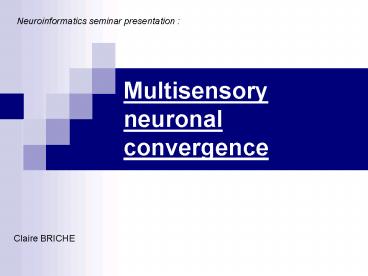Multisensory neuronal convergence - PowerPoint PPT Presentation
1 / 24
Title:
Multisensory neuronal convergence
Description:
Environmental events are converted by the nervous system ... Environmental events can be detected by two or more sensory systems ... Occlusion. Neuron 2 ... – PowerPoint PPT presentation
Number of Views:82
Avg rating:3.0/5.0
Title: Multisensory neuronal convergence
1
Multisensory neuronal convergence
Neuroinformatics seminar presentation
Claire BRICHE
2
Introduction
- Environmental events are converted by the nervous
system to perceptions, memories and/or behaviors. - Environmental events can be detected by two or
more sensory systems (vision, hearing) - Multisensory stimulation
- Neuronal convergence
- Study of the multisensory on the neuronal level.
3
Plan
- Definition of neuronal convergence
- Definition of multisensory convergence
- Description of the superior colliculus
- Characteristics of the multisensory neuronal
convergence - Facilitation
- Interaction
- Inhibition
- Receptive field of multisensory neurons
- Time influence
4
What does neuronal convergence mean?
5
What does multisensory convergence mean? (1)
- Stimuli from differents modalities (vision,
hearing) - Convergence of the information coming from the
different sensory systems onto individual neurons - Response of the neuron (integration of the
information given by the two modalities)
6
What does multisensory convergence mean? (2)
- Different type of multisensory neurons
- Bimodal neurons neurons activated by 2
modalities - Trimodal neurons neurons activated by 3
modalities.
7
The superior colliculus
- Predominant model of multisensory convergence in
mammals. - Includes many multimodal neurons and few unimodal
neurons. - Important role in mammals orientation
- Reticular system (awakening), posterior and
lateral thalamus contain multimodal neurons too.
8
Characteristics of multisensory
convergence facilitation (1)
Enhancement of the multimodal neurons response
with more than one modality
9
Characteristics of multisensory convergence
facilitation (2)
- One modality few spikes
- Two modalities enhancement of the response
(Multimodalidity Convergence) - Excitatory excitatory form of multisensory
convergence.
10
Characteristics of multisensory convergence
facilitation (3)
- Different mechanisms can explain that phenomenon
- Facilitation with spatial summation
11
Characteristics of multisensory convergence
facilitation (4)
- Facilitation with temporal summation
Frequency of the action potentials.
Sum of the epsp (excitatory post-synaptic
potential) coming from neuron 1 and neuron 2 when
they arrive quasi simultaneously.
12
Characteristics of multisensory convergence
facilitation (5)
- Pre-synaptic facilitation
- IPSP (Inhibitory post synaptic potential) for
neuron 1 - Small hyperpolarization of the membrane
- Gain of energy for the action potentials
- Enhancement of the number of neurotransmitter in
the synapse.
Gain of energy
13
Characteristics of multisensory convergence
interaction (1)
Somatosensoriel stimulus (SS)
Auditive stimulus (A)
A SS
- The multimodal neurons response is superior
when two modalities are stimulated. - But the real sum of the two modalities response
is inferior to the sum of the response of one
modality the response of the other modality.
14
Characteristics of multisensory convergence
interaction (2)
- Some explanation
- Occlusion
One of the two modalities is enough to generate
an action potential The addition of the other
modality will not change the response a lot
15
Characteristics of multisensory convergence
interaction (3)
- Recurrent device
- Spatial summation of the EPSP and IPSP
(Inhibitory post synaptic potential) - IPSP attenuates EPSP effects.
16
Characteristics of multisensory convergence
inhibition (1)
- With two modalities, the multisensory neurons
response is attenuated compared with the response
of one modality - Excitatory inhibitory multisensory convergence
17
Characteristics of multisensory convergence
inhibition (2)
- Explanations
- Direct synaptic inhibition
- One of the modalities activates the Neuron 2
- Sum of the IPSP and EPSP
18
Characteristics of multisensory convergence
inhibition (3)
- Presynaptic inhibition
- Small depolarization of the membrane of the
axone of the neuron 1 - Loss of energy for the action potential
- Decrease of the number of neurotransmitter
liberated in the synapse.
Loss of energy
19
Real multisensory convergence
20
Comparison between unimodal and bimodal
convergence.
21
Receptive fields of multisensory neurons (1)
Receptive field sum of the sensory receptors
of the neuron which can modify its activity.
22
Receptive fields of multisensory neurons (2)
Position of the stimulus very important in the
receptive field of each modality.
23
Time influence
After more than 200ms after the first stimulus, a
second stimulus coming from another modality is
taken into account (large time window)
24
Conclusion
- Multisensory convergence on the neuronal level is
not totally understood - Some other unknown mechanisms
- How can the neuron differentiate information
coming from one modality from information coming
from two different modalities?































